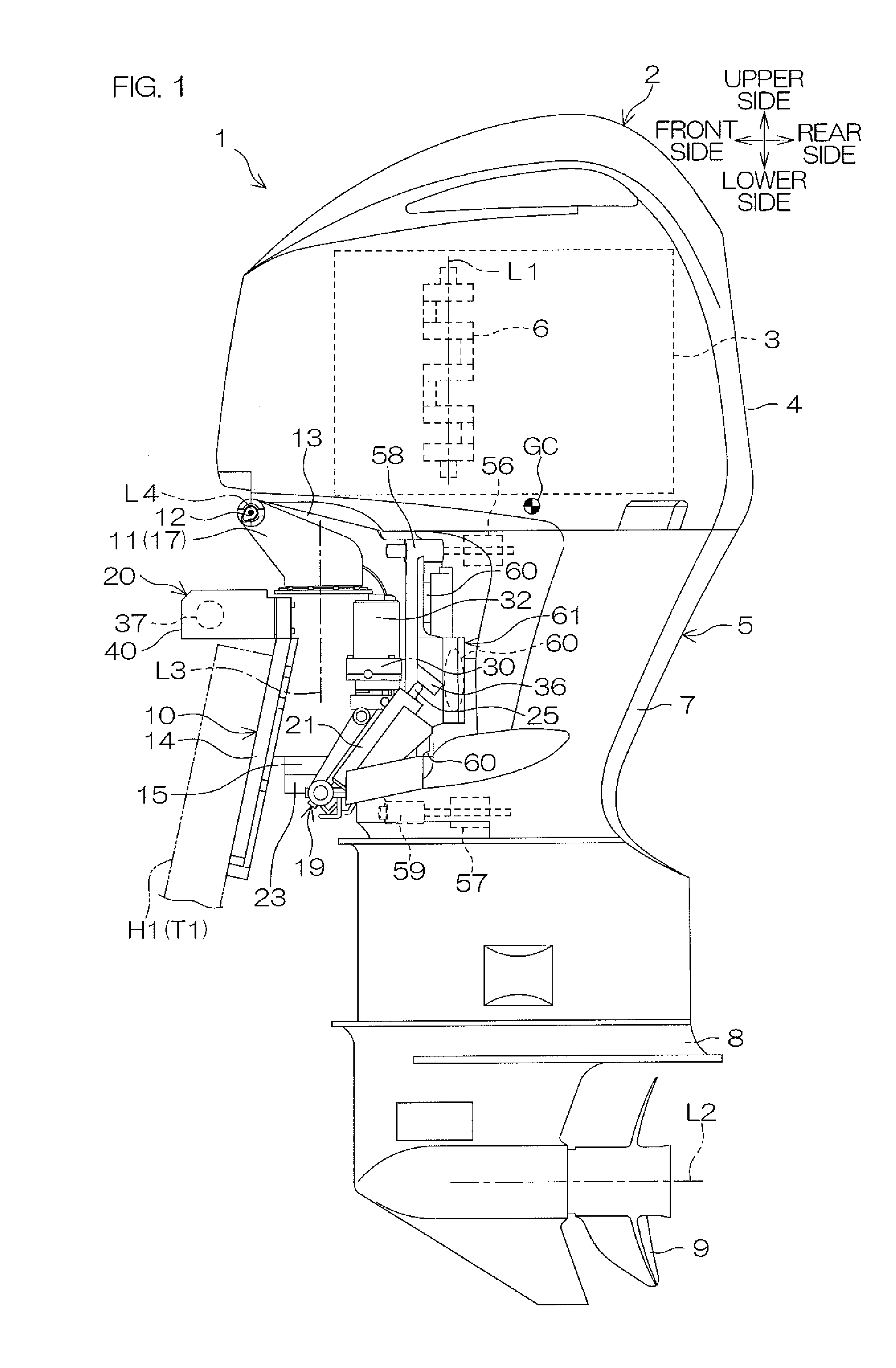Marine vessel propulsion apparatus
a propulsion apparatus and marine technology, applied in marine propulsion, waterborne vessels, vessel construction, etc., can solve the problems of less smooth steering, increased posture holding force of outboard motors, and less than optimal response of outboard motors, so as to reduce the degree of freedom of design of the first mount and the second mount can be further increased, and the effect of reducing the transmission of vibration of outboard motors to the hull
- Summary
- Abstract
- Description
- Claims
- Application Information
AI Technical Summary
Benefits of technology
Problems solved by technology
Method used
Image
Examples
first preferred embodiment
[0056]FIG. 1 and FIG. 2 are side views of a first marine vessel propulsion apparatus 1 according to a first preferred embodiment of the present invention. FIG. 3 is a plan view of the first marine vessel propulsion apparatus 1 according to the first preferred embodiment of the present invention. FIG. 4A is a perspective view of a portion of the first marine vessel propulsion apparatus 1 according to the first preferred embodiment of the present invention. FIG. 4B is an exploded perspective view of a portion of the first marine vessel propulsion apparatus 1 according to the first preferred embodiment of the present invention. FIG. 4C is an exploded view of a portion of the first marine vessel propulsion apparatus 1 according to the first preferred embodiment of the present invention. “GC” in FIG. 1 indicates the gravity center of the outboard motor 2.
[0057]The first marine vessel propulsion apparatus 1 includes an outboard motor 2. The outboard motor 2 is attached to a transom T1 pro...
second preferred embodiment
[0100]FIG. 17 is an enlarged partial sectional view of a portion of a first marine vessel propulsion apparatus 201 according to a second preferred embodiment of the present invention. FIG. 18 is a back view of a tilt bracket 213 and an arrangement relating thereto according to the second preferred embodiment of the present invention. FIG. 19 is a schematic plan view for describing a supported state of an outboard motor 2 according to the second preferred embodiment of the present invention. In FIG. 17 to FIG. 19, constitutional portions equivalent to the portions shown in FIG. 1 to FIG. 16 described above are provided with the same reference numerals as in FIG. 1, etc., and descriptions thereof will be omitted.
[0101]A main difference between the second preferred embodiment and the first preferred embodiment described above is that the first marine vessel propulsion apparatus 201 includes a tilt bracket 213 instead of the tilt bracket 13 according to the first preferred embodiment. A...
third preferred embodiment
[0107]FIG. 20 is a side view of a second marine vessel propulsion apparatus 301 according to a third preferred embodiment of the present invention. FIG. 21A is a perspective view of a portion of the second marine vessel propulsion apparatus 301 according to the third preferred embodiment of the present invention. FIG. 21B is an exploded perspective view of a portion of the second marine vessel propulsion apparatus 301 according to the third preferred embodiment of the present invention. FIG. 21C is an exploded view of a portion of the second marine vessel propulsion apparatus 301 according to the third preferred embodiment of the present invention. FIG. 22 is a partial side view of a portion of the second marine vessel propulsion apparatus 301 according to the third preferred embodiment of the present invention.
[0108]The second marine vessel propulsion apparatus 301 includes the outboard motor 2, the transom bracket 10, a steering shaft 311, the tilt shaft 12, and the tilt bracket 1...
PUM
 Login to View More
Login to View More Abstract
Description
Claims
Application Information
 Login to View More
Login to View More - R&D
- Intellectual Property
- Life Sciences
- Materials
- Tech Scout
- Unparalleled Data Quality
- Higher Quality Content
- 60% Fewer Hallucinations
Browse by: Latest US Patents, China's latest patents, Technical Efficacy Thesaurus, Application Domain, Technology Topic, Popular Technical Reports.
© 2025 PatSnap. All rights reserved.Legal|Privacy policy|Modern Slavery Act Transparency Statement|Sitemap|About US| Contact US: help@patsnap.com



